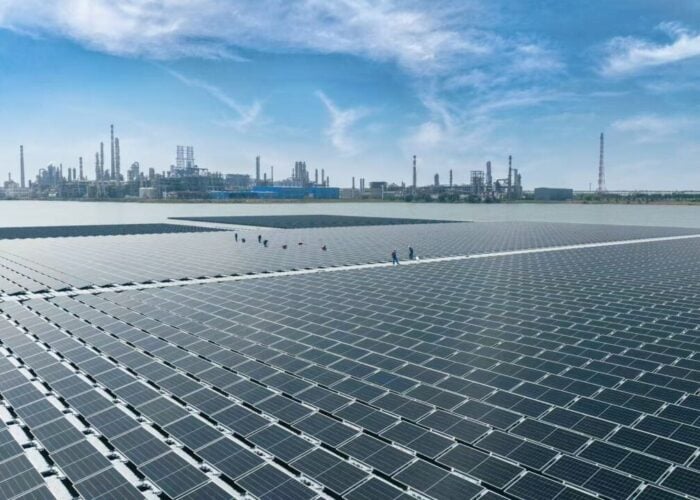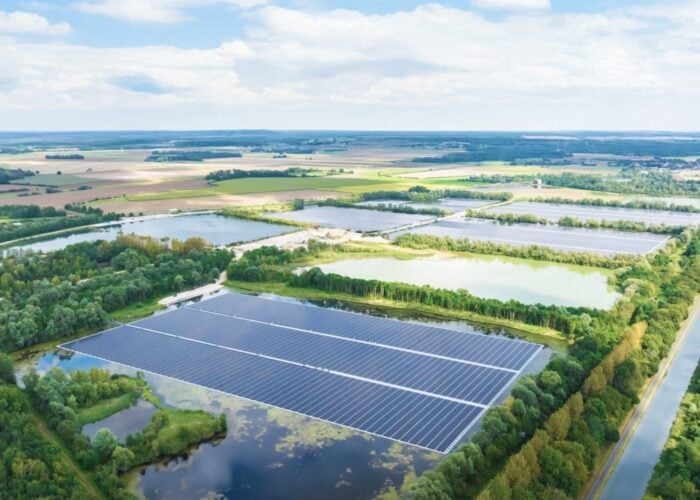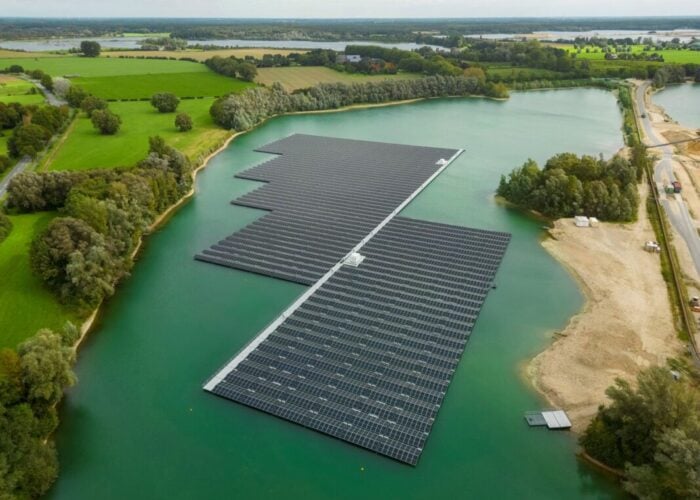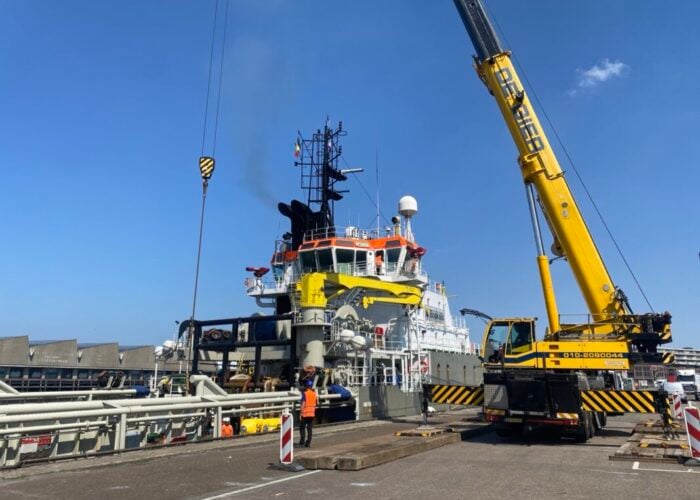
In recent years, the US PV market has witnessed rapid growth and one segment, the topic of today’s discussion, is booming – floating PV.
At the recently concluded RE+ in Las Vegas, Sungrow FPV exhibited its innovative SGF-TS30 floating PV product for the North American market, the solution attracting significant interest from attendees.
Unlock unlimited access for 12 whole months of distinctive global analysis
Photovoltaics International is now included.
- Regular insight and analysis of the industry’s biggest developments
- In-depth interviews with the industry’s leading figures
- Unlimited digital access to the PV Tech Power journal catalogue
- Unlimited digital access to the Photovoltaics International journal catalogue
- Access to more than 1,000 technical papers
- Discounts on Solar Media’s portfolio of events, in-person and virtual
While still at a relatively early stage in its development, the US market is a key one for the company and PV-Tech sat down with VP Lei Wang to gain his insights into the US and, more broadly, the global market.
PV Tech: We’re meeting at RE+ 2023 in Las Vegas – what specific products and solutions are you showcasing this week and how do you view the current status of the US market?
Lei Wang: The US is a key market for us, having such great potential for floating PV. Indeed, WoodMac has predicted that the compound annual growth rate of installed FPV capacity in the United States will reach 13% over the next decade.
At this week’s exhibition, we are displaying our SGF-TS30 product which, with its adjustable snow load, is suitable for use across the entire North American region. We have streamlined the system, reduced the number of different types of material and made it easy to manage. We have optimized the floating body height and width according to differences in height of O&M staff and the body’s buoyancy is sufficiently high to ensure safety and reliability during work.
From your perspective, what are the differences in terms of support for floating PV stations among major markets globally? And to what extent will these differences affect a company’s market development?
Demand for PV installations around the world is still growing. According to analysts, 4.4GW of floating PV capacity was installed worldwide as of the end of 2022. It has also been predicted that, between now and 2030, global FPV demand will reach 24.1GW. At present, governments in Europe, here in the US, Southeast Asia and the Middle East are all actively supporting FPV development with favourable policies.
We view each of these markets as important to our future growth. We have a positive outlook in terms of Europe, the US and Southeast Asia, having enjoyed success in each region with favourable feedback from clients. For the US specifically, Sungrow FPV is more than happy to explore opportunities for cooperation with local partners to close deals and jointly promote the development of floating PV and energy transformation.
Which markets will the company prioritise over the next few years? What changes are likely to occur in those markets and what impact will these changes have on the floating PV industry?
In the coming years, we will continue to focus on Europe, the US, Southeast Asia and the Middle East. With energy transition now a global consensus, floating PV has become one of the most important clean energy sources in each of these markets and I believe that each will upgrade its support for the sector. However, as competition becomes more fierce, issues such as discarding ineffective activities and developing innovative technological breakthroughs need to be addressed. In the face of market changes, we will continue to improve in the dual areas of technological innovation and customer service, while developing high-quality products to protect customer value.
What strategies and product solutions will the company introduce to adapt to future changes in market demand?
The floating PV industry is facing unprecedented development opportunities, with optimized capacity and upgrading significantly changing its structure and pattern. Sungrow is evolving with the times. First of all, we will continue with our commitment to a technology-driven strategy, developing products based on technological innovation and offering highly-efficient and reliable system solutions to the market. Secondly, we will adapt to local conditions to meet increasingly diversified customer needs.
With the global move towards low-carbon energy, the PV market will continue its rapid growth. Sungrow will base its strategy on carrying out market research on a global scale, seeking out new floating PV opportunities.
Looking back over the past couple of years, what would you consider to be the highlights from a Sungrow standpoint in terms of success stories in the floating sector?
We have registered more than 200 patents in the areas of floating body, anchoring system, inverter booster, floating platform and system operation and maintenance. Sungrow FPV was a leader in the compilation of the “Design Code For Floating Photovoltaic Power Station Anchoring Systems” under the management of China’s Photovoltaic Industry Association. This year a technical pre-examination meeting of the Code was convened, marking significant progress in the design of the world’s first floating PV anchoring system standard which, going forward, will have a positive impact on the industry’s development.
The Cirata project currently under construction is another area in which we have introduced innovations in anchoring system technology, designing a 200MW project 100 meters underwater for the first time.
What is your view of new opportunities in offshore PV?
With the maturity of solar power generation and offshore new energy development technology, China is gradually moving towards the ocean. The scale of PV installations on beaches and water is growing year by year, and offshore floating PV in deep sea areas is taking shape. There is no doubt that offshore developments will present a huge future opportunity for the industry at large.
That said, due to the specific nature of the marine environment, such as differences in wind and wave conditions across different regions, we can’t simply follow the experience gained in building inland FPV stations. Sometimes we have to come up with solutions only suitable for one particular region. Offshore FPV technology is still in its infancy, so we will need to carry out more basic research to control risks and optimize investment outcomes.
Sungrow FPV has been looking into offshore floating technology since 2017, overcoming challenges in structural design, environmental load, severe salt-spray corrosion, fouling of settling organisms, anchoring system design and wave reduction technology. In this area, we are open to joining hands with other industry players to agree on standards, in order for the sector to move forward.

As the world pursues energy transformation, what unique contributions can floating PV make in terms of eco-protection and sustainability?
Floating PV does not take up land, can prevent water evaporation and combines well with the fishery industry, so it has received positive feedback in recent years. Floating PV has so far been successfully applied across numerous scenarios such as lakes, rivers, beaches and coastal waters and PV stations built on areas of open water can avoid shading by other objects. Additionally, the cooling effect of water can lower the incidence of temperature loss in PV modules, thus creating 10% more in total power generation than rooftop or ground-mounted PV systems under the same conditions.
Floating PV projects are also designed with a stronger sense of environmental protection. When developing large areas of water systems such as lakes or reservoirs, sustainable principles need to be followed from module coverage proportion to the method of deployment.
Up to now, a considerable number of floating projects have been developed around drinking water resources. Indeed, Sungrow FPV participated in Singapore’s Tengeh reservoir project in 2021, the largest drinking water project to date, the power generated being sufficient to supply 5 water processing plants and meet 7% of the total power demands of Singapore’s Water Supplies Bureau.
We touched earlier on the increasingly fierce competition in the floating sector, both in China and overseas markets – how does Sungrow FPV stay ahead of its competitors?
During recent years, as land resources available for PV installations have become more limited, Sungrow FPV has played an important role with advantages such as lower land occupation, high power generation and compatibility with other industries. Of course, the competition is becoming more fierce, but there are several factors enabling Sungrow FPV to maintain its lead in an increasingly competitive environment.
Firstly, we have confidence in the future of the PV industry, so we can focus all our efforts on developing the floating sector. Secondly, we always prioritise our own independent technological innovations, and invest heavily in product research and on establishing core competitiveness, so that we remain in control of our own destiny. Finally, and perhaps most importantly of all, we are totally committed to the concept of satisfying our customers, putting customer value at the forefront of everything we do.







